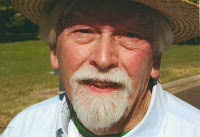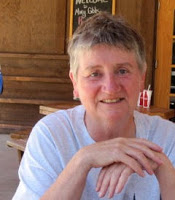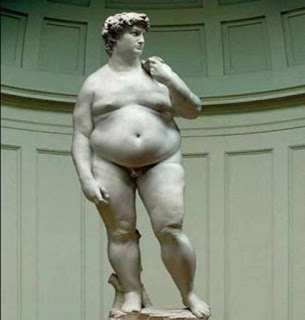I. TRUDY
I
think I am on safe ground in saying that I am likely the serendipitous product
of the unlikely coupling of a lesbian with a man who never seems to have had a
prurient thought in his lifetime.
I
wrote extensively about my mother back on December 2nd of last year. Back then, I did not delve into the
circumstantial evidence for my mother’s lesbianism. I will wade into that somewhat sticky thicket
today, however, as it is the earliest historical instance of the almost
fantastical history of the women in my experience.
Let
us turn the imaginary clock back to May 15th, 1939. The scene is Pratt, Kansas, a place scarcely
touched by the Renaissance, let alone the Enlightenment. Married to Bernard for 12-years with
children, B.J., aged 10, and Joyce, aged 8, Mother filed for divorce on the
grounds of “extreme cruelty”. The Divorce Agreement goes on to claim that
“unfortunate differences and disputes have arisen between the parties and
they have separated with the intention of living separate and apart from each
other during the remainder of their natural life [sic]”.
The
only complaints Mother ever expressed to me about Bernard were that he was an
alcoholic and once came onto their porch distraught and tearfully imploring her
to take him back. She berated his lack
of manliness. My half-sister and
-brother, who continued to see their father until his death, told me that he was
not an alcoholic.
Here’s
where the Divorce Agreement gets bizarre:
“There have been two children born of this marriage…They are now
living with the husband and he is to have the care and custody of said children
in the future. In this connection the
said husband agrees to be responsible for the support and maintenance of said
children. It is further agreed that the
wife shall be permitted to see and visit said children and said children are to
be allowed to see and visit with her.
“It
is further understood and agreed that the husband and wife, since their
marriage, have accumulated but little real and personal property…and they
have some personal property, including an automobile. All of said property is to belong to the
husband, except any items of personal property belonging to the wife.”
Then,
comes this little tidbit: “…[T]he
said wife does hereby release and discharge the said husband from all
obligations of support and from all claims and duties arising out of their
marital relations.”
Within
a year-and-a-half, my mother had married again, this time to my father. It was his first marriage. I’m not certain of the date of their first
meeting, but I do know where it took place.
Dad had an office on the second floor of the Sears department store in downtown
Pratt where my mother and another woman operated a beauty parlor. At some point in this interval between
“Hello” and “I do”, Mom’s business partner unceremoniously
departed for California. My suspicion is
that Mom got caught in a gay tryst and surrendered all rights to parentage and
property to silence Bernard. That would
also explain the sudden departure of mom’s business partner for the west coast.
Since
I have covered some of this ground before, I will not repeat myself. Suffice it to say that for as long as I can
remember, Mom and Dad slept in twin beds.
From the time I was six, Dad dressed in another room. I never remember seeing them kissing or
hugging or showing any form of physical affection during their 49-year marriage. Was Mom gay?
Dad? Both? Neither?
Perhaps they were perfectly suited marital partners–each as cover for
the other at a time when being gay was strictly verboten. I’ll probably never know for certain.
II. JOYCE
Joyce
was Mom’s second child by her first husband, Bernard. I have mentioned her before in one of these stories
as the young woman who gave me such a thrill when she stayed overnight in my
bed when I was about 3 or 4 years old.
She was truly beautiful and a dear, sweet person. I adored her and so did my mother.
As
long as I can remember, Joyce was married to Moe. Moe was an engineer on the railroad. They lived in Pratt. They had two children, a boy, Damon, followed
a couple years later by a girl, DeeAnn.
I was an uncle at the age of 9.
When they came to visit, Mom and Joyce would go shopping and I would
play with my niece and nephew. We all
got along famously.
When
she was 55, Joyce was afflicted with pancreatic cancer and soon died. It was a terrible blow to the family, and my
mother in particular. I will treasure
her memory forever.
III. SANDY SUE
Before
I started school, my best friend was Sandy Sue.
She lived in a corner house at the far end of the block. She had a basement where we could play
hide-and-seek. Sometimes, when other
kids were around, we would play spin-the-bottle. On one occasion, Sandy Sue and I were in the
basement playing with matches. Somehow–I’m
pretty certain I had a roll to play–a wastebasket was set on fire. The flames shot up as high as my head. We both panicked. Sandy’s mother must have heard something or
smelled smoke because she came running down the stairs and put out the
fire. I was sent home, now as a persona
non grata.
IV. JUDY
When
I was half-way through kindergarten, my parents moved into a small ranch house
with three bedrooms so my maternal Granddad could live with us and Dad could
have an office at home. On moving day, I
was standing in the front yard taking in the new surroundings when I heard a
voice approaching from behind. It was
Judy. She was what they used to call a
tomboy. She grew up with three older
brothers and liked to do things that boys like to do. Although I was pretty shy, we became the best
of friends.
I
should have known by then that playing in basements invited risky behaviors. When we were about 10–Judy was 12 days
younger than I–we were playing hide-and-seek in her basement when she said,
“Let’s play doctor!”
“How do you play
‘doctor’?”, I naively queried.
“Well, I’ll be the
doctor first and you’ll be the patient, then we’ll switch”, she
replied. “You’ll start by taking
off your clothes.”
“Oh, no,” I blurted
out.
“Don’t worry. I do it with my brother and he doesn’t
mind.”
“If you insist, I’m
leaving.”
“OK, I won’t
insist,” she said.
I’ve
often wondered whether, had I not been so unaccustomed to being naked in the
presence of others or had I not been an inchoate gay boy, might I have
responded differently to Judy’s entreaty.
When
we were 5th graders, Judy and her family moved to Wichita. Much later, on a visit when we were 19, she
proposed to me. By that time, I
understood why “playing doctor” with her had not aroused my
curiosity. I told her “No”,
once again. By that time, her family was
living in Evergreen, CO, and I saw her only infrequently. She married, then divorced, then married
again and is now living in Arvada. We
are still friends though no longer close.
V. JANET
After
graduating from the University of Kansas with a Mechanical Engineering degree
in January of 1970, I took a job with Ford in Dearborn, MI. For the first time in my life, I had neither
school nor friends to keep me busy. I
had lots of time to think about who I was and where my life was going. I decided to get some professional counseling. After many visits, I told my psychologist
that I was sexually attracted to men.
His advice was to tell me that I would be happy if I simply found the right
woman. Within less than a year, I had met
a woman and we started dating. I was
very uncomfortable and must have telegraphed my discomfort. It only lasted a couple of months.
Soon,
I was feeling secure enough in my orientation that I wanted to come out to my
parents back in Kansas. I told my
therapist that I was thinking of writing them a “coming out” letter. He said that would be a terrible mistake, so
I didn’t.
About
six months later I went to a Christmas party attended by clients of my
therapist’s two group sessions. I struck
up a conversation with a young woman who was a member of the other group or,
should I say, she struck up a conversation with me. Her name was Janet and we talked for two
hours. Like Judy, she was extroverted,
very down-to-earth, and knew her own mind.
Not liking to linger at parties, I politely excused myself, said my
“goodbyes” and left. As I was
getting into my car, a man known to both Janet and me came rushing out of the
house with a note in his hand. It was
Janet’s phone number.
Well,
I did call her a few days later. We had
many interests in common and began to see each other regularly. I even told her of my interest in men. Janet had been “around the block”,
shall I say, sexually, having once been a member of the Sexual Freedom League,
an organization formed in 1963 in New York City which, to quote Wikipedia, “existed to promote and conduct
sexual activity among its members and to agitate for political reform,
especially for the repeal of laws against abortion and censorship, and had many
female leaders”. The fact that
Janet had been raised in a Polish Catholic family but had rejected the Church
while still in college for its sexism, only made her more attractive to me.
Within
three months or so, we were having sex regularly. I can remember driving to work from her
apartment after spending the night wondering if my co-workers could detect the
odor of our coupling.
We
were about to have sex in my bedroom on one day that July of 1972 when Janet
asked me if I was still attracted to men.
I answered truthfully, “Yes”.
She then wanted to know if I was still committed to marital monogamy, a
subject we had discussed at length. I
answered in the affirmative. She was
happy with that.
We
married that fall in the Unitarian Universalist Church in Rockford, IL. The minister had been at the Detroit UU
Church when we first met. Her family came
from Michigan, mine from Minnesota and Kansas, so the location was a good
compromise.
That
night, there was no latex involved in our love-making. By Thanksgiving, Janet began spotting. Something was wrong. I have already told this story, so I’ll spare
you now, except to say that we lost that child.
Eventually, luck being with us, we had two children, a girl and a boy.
I
was absolutely true to my word and remained faithful to Janet throughout the 26
years of our marriage, as she was to me.
Oh, I had a rich fantasy life and that kept me going, so to speak. We both had careers, she as an elementary
school teacher and I as an automotive engineer.
Neither of us lived to work, however, and no housework nor child care
activity was beneath either of our dignities.
As
time went on, however, I found it increasingly difficult to sublimate my gay
inner persona. I began to focus more and
more at home on my hobby, thinking that merely being “present” was
parenting enough. It wasn’t, though it
took me many years to figure that out–at a cost of much pain to my kids. I won’t dwell on this now. That will be the subject for another Monday
afternoon.
Let
it suffice to say that Janet and I are still friends to this day, despite
divorcing in 1999. Janet stated emphatically
that she would never remarry and she has held true to that conviction. She lives close enough to both kids to see
them regularly. She spends her time
playing clarinet in three community bands, taking watercolor classes, and
visiting friends. She has a number of
serious health issues and is scheduled for hip replacement surgery in December.
For
a quarter century, we were as close as any man and woman I have ever
known. She brought me blessings by the
bucketful. I couldn’t have asked for a
more loving companion and partner.
LAURA/CALIX
I
have already written about Laura’s difficult delivery using forceps on her head
while the doctor pulled the delivery table, a nurse, and me across the delivery
room floor. I also told about the first
time I held her in my arms when she was less than a day old, removing the
hospital gown I had been given only to find a blob of baby poop on my dress
shirt. Yes, it was very early in my
daughter’s life that I knew who was calling the shots.
Calix
was not the name Janet and I gave her at birth.
That was “Laura”.
“Calix” is the name our daughter assumed when she became an
adult. Other than both consisting of
five letters, the second of which is ‘a’, the two names could hardly sound more
different. It was just another milestone
on her journey toward becoming her own person.
Is
it a rule of parenting that, if one of your children is neat, punctual,
compliant, unassuming and shy, the other will be passive-aggressive, messy,
contrary, and stubborn? If so, how much of
that is rebellion, how much life experience, and how much luck-of-the-draw?
In
1980, Janet and I, with our daughter about to enter kindergarten, moved from
Detroit to the tony suburb of Grosse Pointe Farms, where Janet taught 4th
grade. For the 7-1/2 years we lived in
the big city, we had not had so much as a lawn sprinkler stolen, although it
had been slightly unnerving to watch the tree limbs drop to the ground as the
next-door neighbors and their friends fired their guns into the sky on New
Years’ Eve.
Five
months after moving in, Janet and I attended a Detroit Symphony Orchestra
concert. The baby-sitter we had hired–and
her parents–were known to Janet through her teaching. The girl was 13 but kind of new to
baby-sitting, certainly new to us. After
the concert, we had been invited to the home of one of Janet’s fellow teachers for
coffee. Driving home around 12:30 AM, we
could see from a couple of blocks away flashing red lights in the vicinity of
our house. As we pulled into the drive,
the side door opened and a plainclothes policeman approached the car. He ushered us inside. There had been some trouble.
Earlier
in the evening, a woman known only superficially to Janet had been in the
emergency waiting room of a local hospital with a couple of friends. They were trying to get her committed for
psychiatric care but needed the signature of a second doctor because it was
without the patient’s consent. At some
point, the distraught woman had simply walked out of the hospital and took off on
foot in the direction of our house. She
had gone nearly two miles when a neighbor noticed her in the middle of the
street, shedding clothes as she went.
The neighbor called the police.
We had left the side porch light on.
Whether that was what attracted the woman to our house or not, I don’t
know. She walked up to the side door naked
from the waist up and rang the bell. I’m
sure she was verbalizing, as well.
When
the baby-sitter saw her, she turned back and ran to the kitchen, where there
was a phone. She called her home. Her dad answered. Meanwhile, the woman broke a small window
glass in the side door and let herself in.
She walked up to the sitter and began running her fingers through the
girl’s hair, upon which the babysitter dropped the phone and ran out the
door. At this point, the woman began
rummaging through the kitchen drawers, looking for something to use as a
weapon. All she found, luckily, was a
pair of vegetable shears. She set out
looking for a victim.
The
babysitter ran screaming toward a couple across the street walking their
dog. She tried to tell them which house
she had come from but, in her panic and unfamiliarity, wasn’t sure. At just this moment, a cop car came down the
street in response to the phone call reporting that a woman was taking off her
clothes and dropping them on the street.
The
distraught woman walked right past the bedroom where our two-year-old son was
sleeping to the far end of the ranch house and into Laura’s bedroom. Waking her, she knelt over her and began to
make mostly superficial stab wounds over Laura’s face, torso, and near her
vagina. The most serious of the wounds
penetrated Laura’s lower lip.
When
the police entered the house, they saw the woman wielding the scissors while
repeating, “I have to kill the children”. It took three officers to wrestle the woman
to the floor and put her coat back on to take her away.
Laura
was not seriously hurt physically. All
of the wounds healed on their own except for the one to the lip, which required
a stitch or two. At the commitment
hearing for the woman, I sat just in front of her husband, who whispered to me that
all women are just a hair away from mental instability once a month
anyway. She was committed to a mental
hospital for 90 days, after which she was released to the care of her loving
husband.
Janet
and I sought counseling for Laura immediately.
Some of the advice we got was less than useful, though we did not
realize it right away. I’m sure some of
it did more harm than good, including setting up a point system to reward good
behavior and punish bad. Laura had
always been late for everything, slow to dress, having to be coaxed to get
ready for school, on and on. She started
sucking her thumb and continued doing it into high school. It caused her mother and me no end of
frustration.
In
high school, Laura befriended a girl who also was an outsider. Their relationship was so close that other
kids thought they were lesbians. Our
son, Nolan, two years younger, was teased about that when he started high
school. In their senior year, Laura and
the other girl had a falling out. The
other girl brought a knife to school and threatened Laura with it. Laura became depressed. She was hospitalized and diagnosed with PTSD,
probably from the incident when she was four.
Calix
was a talented poet and artist. She went
on to college hoping to teach philosophy but ran into a brick wall when it came
to writing term papers. She not only had
PTSD but also ADD and Generalized Anxiety Disorder. At age 38, she is still a year away from a
bachelor’s degree and works for $9 an hour at a clothes cleaning establishment.
Four
years ago, she married the love of her life, Scott. He works at Walgreen’s as a clerk though he
holds an MBA which he earned online.
Together, they made $25K last year and have, between them, over $70K in
college loan debt. They are living
almost from hand-to-mouth and their future is far from bright. They seem happy, though they cannot afford
to have the child they so much desire, and I am happy for them. It’s nothing like the life Janet and I wanted
for her but it will have to do.
EPILOGUE
There
is another woman who has played a critical role in my life. She was my son’s girlfriend back in
2008. Her name was Jasmine. Nolan has a penchant for dating women with
exotic names–Alethea, Jasmine, and Destiny among them.
One
night in late February of 2008, Jasmine came to confront Nolan in his apartment
after he had sought to break off the relationship. Jasmine picked up a knife and stabbed Nolan
in the throat, just missing his carotid artery by 2 mm. He ran down the stairs and into the attached
garage. He got into his car and pressed
the garage door opener. Jasmine followed
him to the garage and used the button near the inside door to close the garage
door again. She still clutched the
knife. Nolan got out of the car, ducked
under the closing door and ran from neighbor to neighbor, barefoot, pajama-clad
and bleeding in the snow, seeking help.
After several rebuffs, an elderly woman let him in. Jasmine was tried and went to jail for four
months following a plea bargain, despite evidence that she had used Nolan’s
computer to research the anatomy of the human neck, including the location of
the critical artery.
I
believe I am truly unique in the fact that both of my children were at one point
in their lives stabbed by emotionally distraught, if not downright loony,
women. I think that gives me a somewhat
unique perspective although I have no idea as to what.
© 24 Nov 2012
About
the Author
I came to the beautiful state
of Colorado out of my native Kansas by way of Michigan, the state where I
married and I came to the beautiful state of Colorado out of my native Kansas
by way of Michigan, the state where I married and had two children while working
as an engineer for the Ford Motor Company. I was married to a wonderful woman
for 26 happy years and suddenly realized that life was passing me by. I figured
that I should make a change, as our offspring were basically on their own and I
wasn’t getting any younger. Luckily, a very attractive and personable man just
happened to be crossing my path at that time, so the change-over was both
fortuitous and smooth.
Soon after, I retired and we
moved to Denver, my husband’s home town. He passed away after 13 blissful years
together in October of 2012. I am left to find a new path to fulfillment. One
possibility is through writing. Thank goodness, the SAGE Creative Writing Group
was there to light the way.













